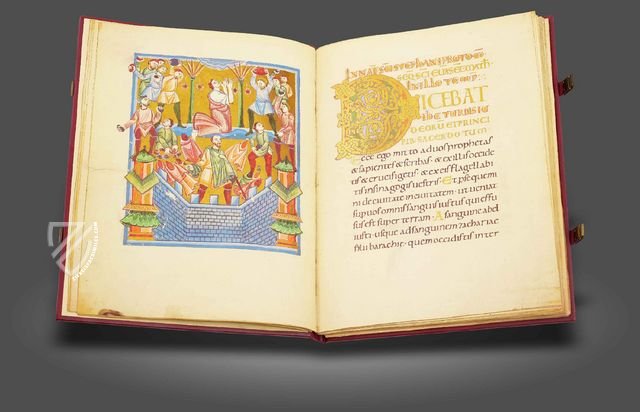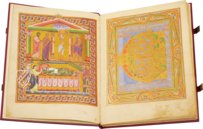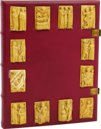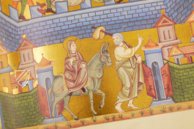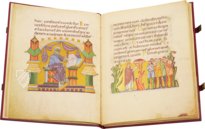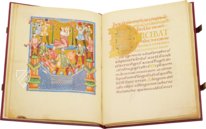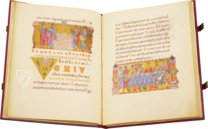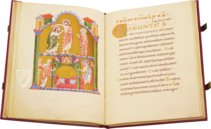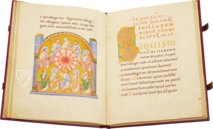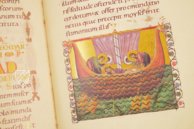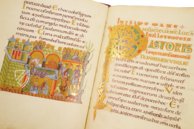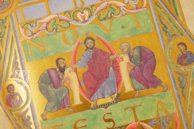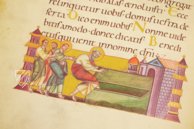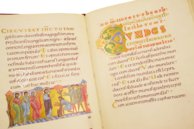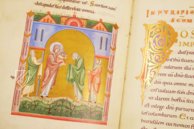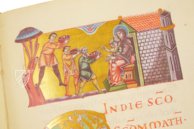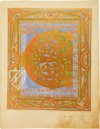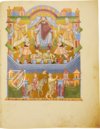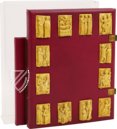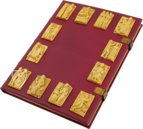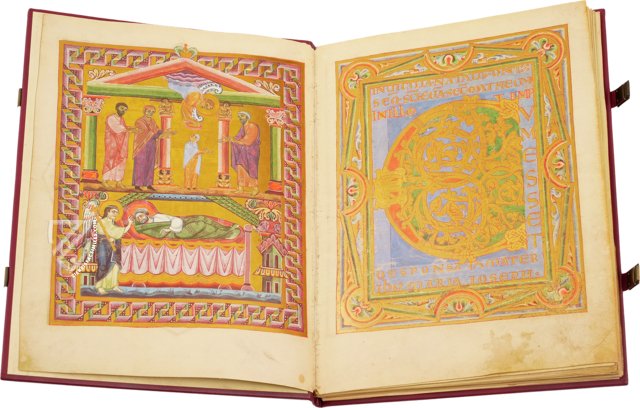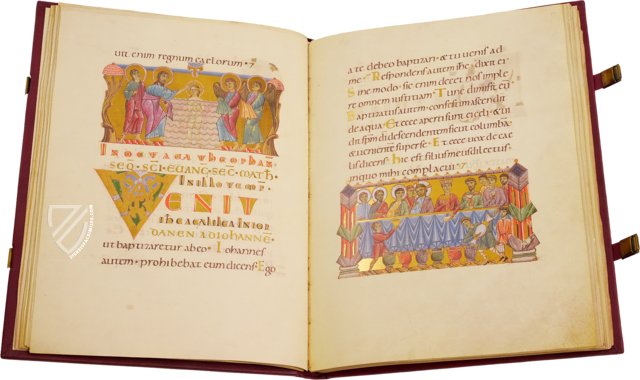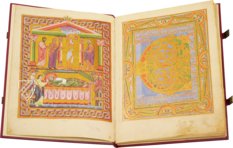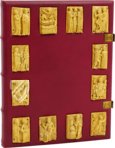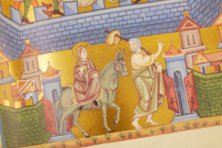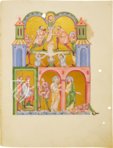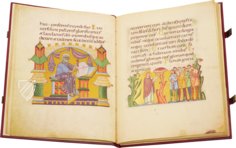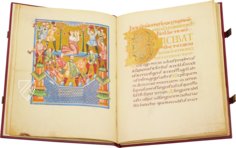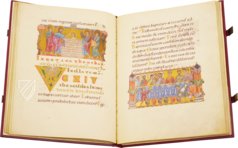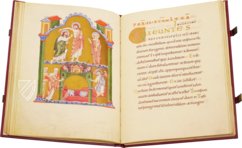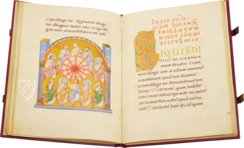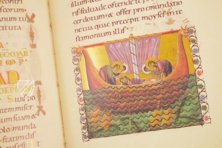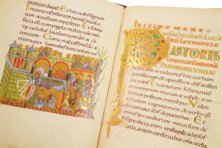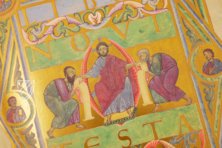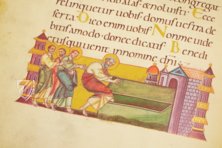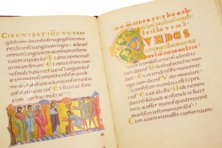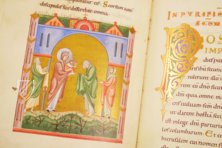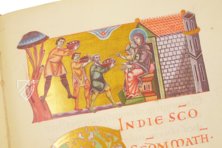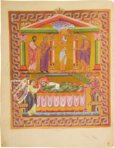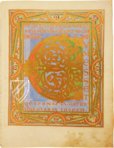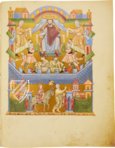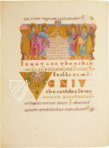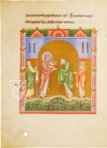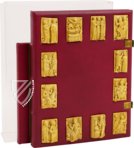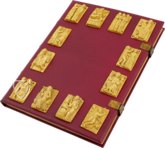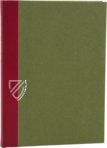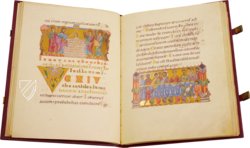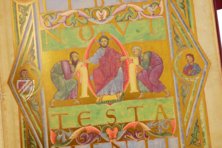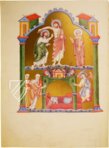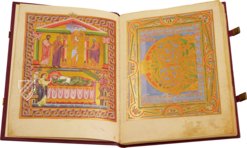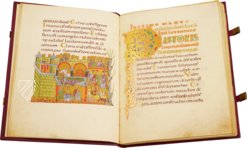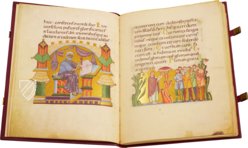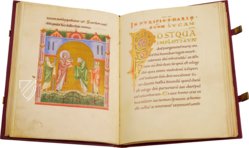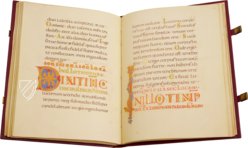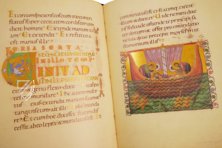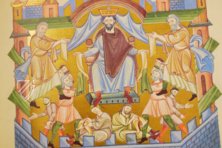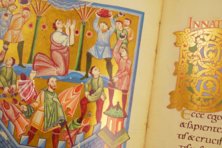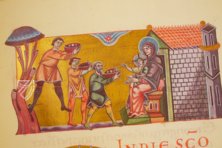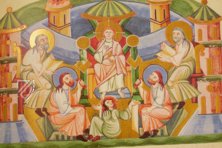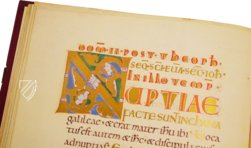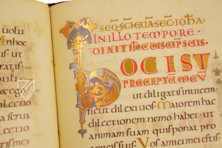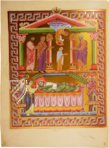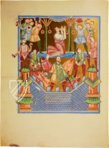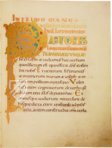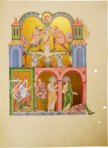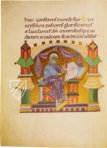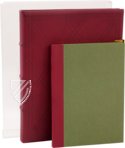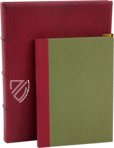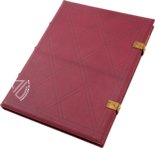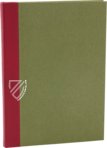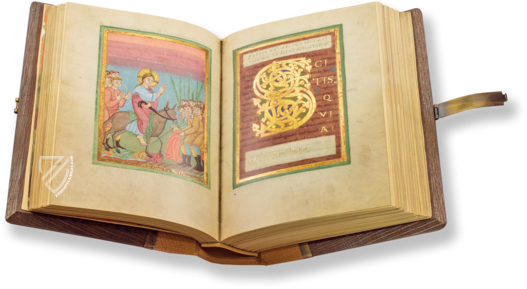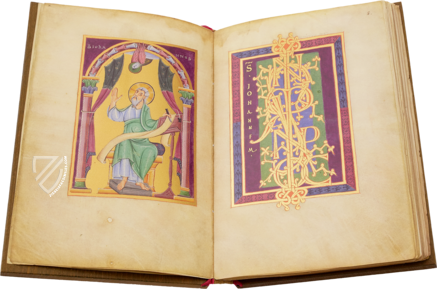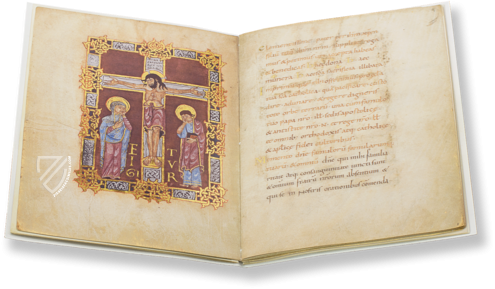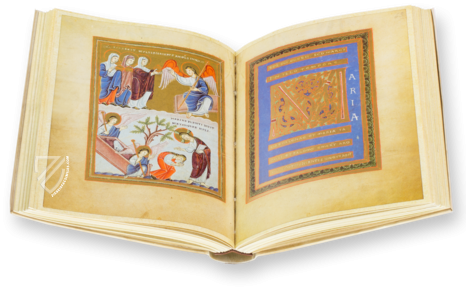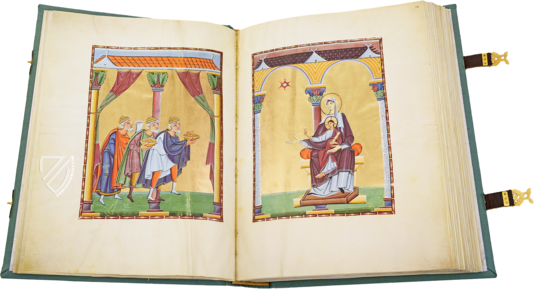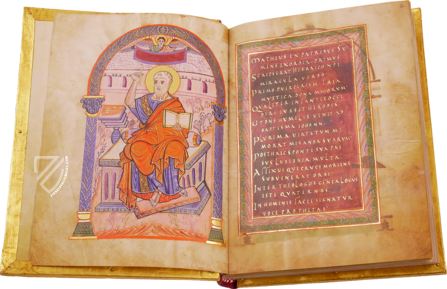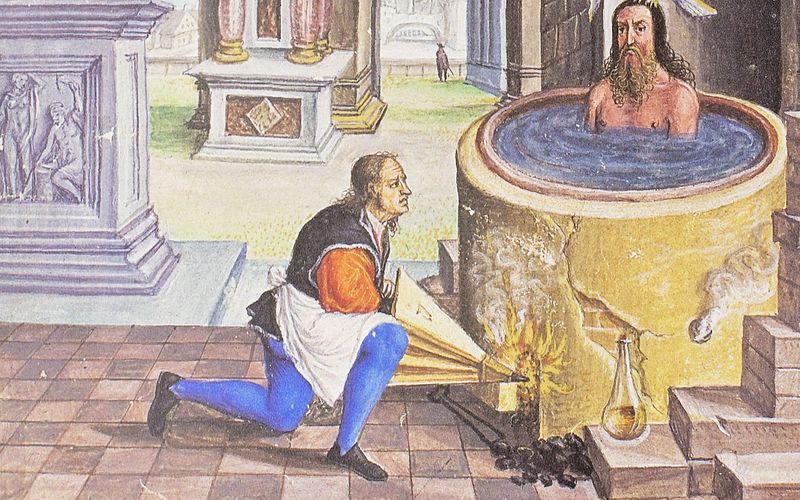Salzburg Pericopes
(3,000€ - 7,000€)
The stunning Salzburg Pericopes are unquestionably one of the most impressive examples of Ottonian book art. Created by several hands at the time of Emperor Henry II (973/978–1024) in the important scriptorium of the ancient St. Peter's Abbey in Salzburg, it amazes to this day with its exuberant abundance of golden illumination. The 19 masterful, full-page miniatures and decorated pages as well as some 70 splendid, golden initials with scroll ornament reflect a variety of stylistic influences, such as Byzantine and Lombard, but also in particular Regensburg book illumination, which was in its heyday at the time. Remarkably, this magnificent masterpiece, which contains texts for the liturgical celebration of the Christian high feast days, was not commissioned by a king, but was actually patronized by the Archbishop of Salzburg himself, Hartwig von Ortenburg (d. 1023), and was probably used by him personally.
Salzburg Pericopes
The Salzburg Pericopes stands in the tradition of Ottonian book art and in a row with the most important manuscripts of European illumination. It originated in the scriptorium of St. Peter’s Abbey in Salzburg at the time of Emperor Henry II and amazes to this day with its opulently artistic furnishings with gold. A variety of stylistic influences find expression in the masterful miniatures.
An Ostentatious Clerical Commission
Unlike the many magnificent manuscripts that originated from sovereign-commissioned works, the Salzburg Pericopes itself probably was a commission from the ranks of the clergy: for Hartwig von Ortenburg, Archbishop of Salzburg. A pericopes, with readings from the gospels for church festivals, was used for the solemn masses in the cathedral on high holidays. In terms of splendor and configuration, the Salzburg Pericopes is second to no other Ottonian manuscripts. It was taken to Paris in the 19th century as a spoil of war but nevertheless returned after the end of the Napoleonic rule, and so became a highlight of the manuscript collection of the Bavarian State Library in Munich, where it is housed today.
An Impressive Example of Salzburg Illumination
For the design of the Pericopes, the scriptorium of St. Peter’s Abbey in Salzburg, the oldest monastery in the German-speaking world, offered the archbishop everything of artistic value that it had to offer. Many artistic movements met one another in Salzburg, combining the best aspects in the work on the Salzburg Pericopes. Various different hands, which can be differentiated from one another by the miniatures and decorative initials, bespeak influences from Byzantine, Lombard, and western European illumination. Particularly noticeable is the stylistic affinity to the highly-prized book art of Regensburg with its bright color palette and characteristic head types. The 19 sometimes full-page miniatures, both the decorative pages and pictures of the Evangelists as well as the cycles of scenes from the New Testament, impress through their strict and exact composition. Complicated architectural borders surround elaborately composed scenes, which focus on the essentials, but nevertheless spare no decorative elements. The design of the backgrounds for the pictures with large gold surfaces is another prominent feature. The various artists working on the miniatures – all of them masters of their craft – slipped their own pictorial inventions in the design. So a completely new composition was sought for the famous depiction of the Storm on the Sea of Galilee, which simultaneously shows the storm and the calm afterward and amazes in its sophisticated simplicity.
A Splendid General Impression
Not only the miniatures, but also the numerous small and large initials contribute to the valuable artistic adornment of the Salzburg Pericopes. In particular the 70 embellished initials, partly adorned with gold, are second to none. The sumptuous general impression of the manuscript is completed through the binding of red leather, the front cover of which is adorned with 12 small ivory plates. These works of art are the product of southern French or northern Spanish works from the 11th century, therefore they fit chronologically with the Pericopes.
Codicology
- Alternative Titles
- Salzburger Perikopenbuch
- Size / Format
- 140 pages / 37.2 × 29.0 cm
- Origin
- Austria
- Date
- Around 1020
- Epochs
- Style
- Language
- Illustrations
- 19 miniatures, ca. 70 decorated initials
- Patron
- Hartwig von Ortenburg (died 1023), Archbishop of Salzburg
Salzburg Pericopes
King Herod
In the Book of Matthew, it tells how the Magi came out of the East and asked King Herod where they might find the King of the Jews, arousing Herod’s paranoia that there was a threat to his reign. Joseph was warned in a dream of the coming Massacre of the Innocents and the Holy Family sought safety in Egypt until Herod died. Behind the walls of a castle and dressed in the style of an Ottonian monarch, the King of Judea is shown surrounded by his priests, advisors, and scribes.
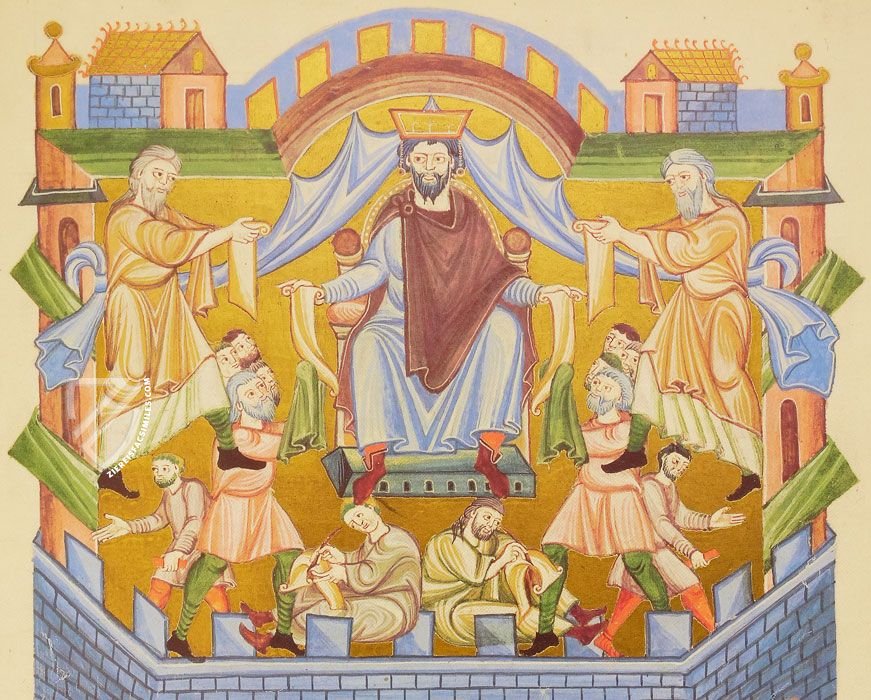
Salzburg Pericopes
Presentation of Jesus in the Temple
One of the events in the early life of Jesus is commonly depicted in art as a combination of Judaism’s purification rite with the ceremony of the redemption of the firstborn. The Virgin Mary presents Jesus to Simeon, the high priest, and the prophetess Hannah, while Joseph stands back holding a brace of doves in his hands.
A characteristically Ottonian scene: sober figures with dramatic gestures and glances silhouetted against a burnished gold background, framed by a classical architecture and wearing togas, all in bright, elevated primary colors. The great arch and flowering bushes indicate they are being greeted at the temple’s entrance. Finally, the halos of the Virgin Mary and the Baby Jesus are rendered in silver leaf to contrast with the background.
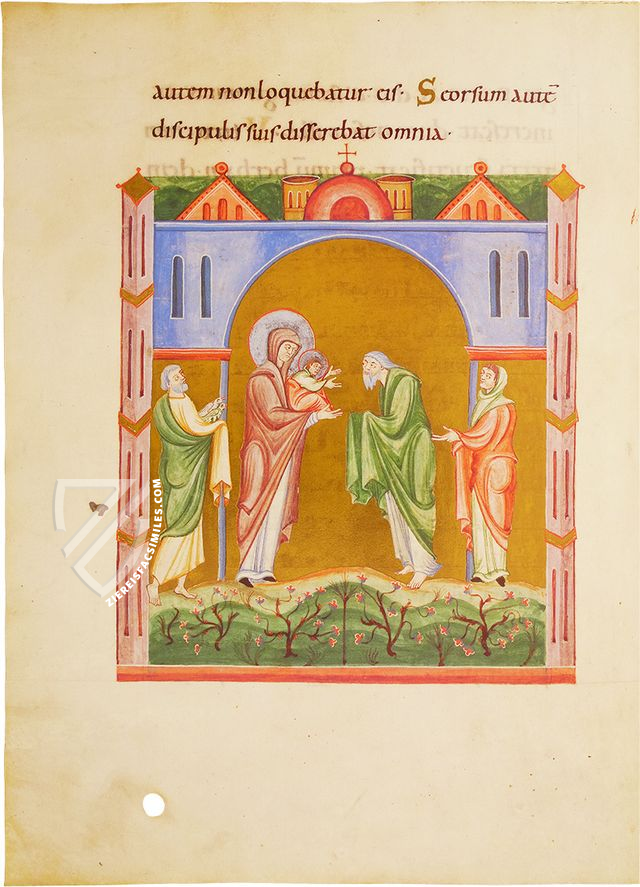
#1 Salzburger Perikopenbuch (De Luxe Edition)
Language: German
(3,000€ - 7,000€)
#2 Salzburger Perikopenbuch (Standard Edition)
Language: German
(1,000€ - 3,000€)
- Treatises / Secular Books
- Apocalypses / Beatus
- Astronomy / Astrology
- Bestiaries
- Bibles / Gospels
- Chronicles / History / Law
- Geography / Maps
- Saints' Lives
- Islam / Oriental
- Judaism / Hebrew
- Single Leaf Collections
- Leonardo da Vinci
- Literature / Poetry
- Liturgical Manuscripts
- Medicine / Botany / Alchemy
- Music
- Mythology / Prophecies
- Psalters
- Other Religious Books
- Games / Hunting
- Private Devotion Books
- Other Genres
- Afghanistan
- Armenia
- Austria
- Belgium
- Belize
- Bosnia and Herzegovina
- China
- Colombia
- Costa Rica
- Croatia
- Cyprus
- Czech Republic
- Denmark
- Egypt
- El Salvador
- Ethiopia
- France
- Germany
- Greece
- Guatemala
- Honduras
- Hungary
- India
- Iran
- Iraq
- Israel
- Italy
- Japan
- Jordan
- Kazakhstan
- Kyrgyzstan
- Lebanon
- Liechtenstein
- Luxembourg
- Mexico
- Morocco
- Netherlands
- Palestine
- Panama
- Peru
- Poland
- Portugal
- Romania
- Russia
- Serbia
- Spain
- Sri Lanka
- Sweden
- Switzerland
- Syria
- Tajikistan
- Turkey
- Turkmenistan
- Ukraine
- United Kingdom
- United States
- Uzbekistan
- Vatican City
- A. Oosthoek, van Holkema & Warendorf
- Aboca Museum
- Ajuntament de Valencia
- Akademie Verlag
- Akademische Druck- u. Verlagsanstalt (ADEVA)
- Aldo Ausilio Editore - Bottega d’Erasmo
- Alecto Historical Editions
- Alkuin Verlag
- Almqvist & Wiksell
- Amilcare Pizzi
- Andreas & Andreas Verlagsbuchhandlung
- Archa 90
- Archiv Verlag
- Archivi Edizioni
- Arnold Verlag
- ARS
- Ars Magna
- ArtCodex
- AyN Ediciones
- Azimuth Editions
- Badenia Verlag
- Bärenreiter-Verlag
- Belser Verlag
- Belser Verlag / WK Wertkontor
- Benziger Verlag
- Bernardinum Wydawnictwo
- BiblioGemma
- Biblioteca Apostolica Vaticana (Vaticanstadt, Vaticanstadt)
- Bibliotheca Palatina Faksimile Verlag
- Bibliotheca Rara
- Boydell & Brewer
- Bramante Edizioni
- Bredius Genootschap
- Brepols Publishers
- British Library
- C. Weckesser
- Caixa Catalunya
- Canesi
- CAPSA, Ars Scriptoria
- Caratzas Brothers, Publishers
- Carus Verlag
- Casamassima Libri
- Centrum Cartographie Verlag GmbH
- Chavane Verlag
- Christian Brandstätter Verlag
- Circulo Cientifico
- Club Bibliófilo Versol
- Club du Livre
- CM Editores
- Collegium Graphicum
- Collezione Apocrifa Da Vinci
- Comissão Nacional para as Comemorações dos Descobrimentos Portugueses
- Coron Verlag
- Corvina
- CTHS
- D. S. Brewer
- Damon
- De Agostini/UTET
- De Nederlandsche Boekhandel
- De Schutter
- Deuschle & Stemmle
- Deutscher Verlag für Kunstwissenschaft
- DIAMM
- Droz
- E. Schreiber Graphische Kunstanstalten
- Ediciones Boreal
- Ediciones Grial
- Ediclube
- Edições Inapa
- Edilan
- Editalia
- Edition Deuschle
- Edition Georg Popp
- Edition Leipzig
- Edition Libri Illustri
- Editiones Reales Sitios S. L.
- Éditions de l'Oiseau Lyre
- Editions Medicina Rara
- Editorial Casariego
- Editorial Mintzoa
- Editrice Antenore
- Editrice Velar
- Edizioni Edison
- Egeria, S.L.
- Eikon Editores
- Electa
- Emery Walker Limited
- Enciclopèdia Catalana
- Eos-Verlag
- Ephesus Publishing
- Ernst Battenberg
- Eugrammia Press
- Extraordinary Editions
- Fackelverlag
- Facsimila Art & Edition
- Facsimile Editions Ltd.
- Facsimilia Art & Edition Ebert KG
- Faksimile Verlag
- Feuermann Verlag
- Folger Shakespeare Library
- Franco Cosimo Panini Editore
- Friedrich Wittig Verlag
- Fundación Hullera Vasco-Leonesa
- G. Braziller
- Gabriele Mazzotta Editore
- Gebr. Mann Verlag
- Gesellschaft für graphische Industrie
- Getty Research Institute
- Giovanni Domenico de Rossi
- Giunti Editore
- Graffiti
- Grafica European Center of Fine Arts
- Guido Pressler
- Guillermo Blazquez
- Gustav Kiepenheuer
- H. N. Abrams
- Harrassowitz
- Harvard University Press
- Helikon
- Hendrickson Publishers
- Henning Oppermann
- Herder Verlag
- Hes & De Graaf Publishers
- Hoepli
- Holbein-Verlag
- Houghton Library
- Hugo Schmidt Verlag
- Idion Verlag
- Il Bulino, edizioni d'arte
- ILte
- Imago
- Insel Verlag
- Insel-Verlag Anton Kippenberger
- Instituto de Estudios Altoaragoneses
- Instituto Nacional de Antropología e Historia
- Introligatornia Budnik Jerzy
- Istituto dell'Enciclopedia Italiana - Treccani
- Istituto Ellenico di Studi Bizantini e Postbizantini
- Istituto Geografico De Agostini
- Istituto Poligrafico e Zecca dello Stato
- Italarte Art Establishments
- Jan Thorbecke Verlag
- Johnson Reprint Corporation
- Josef Stocker
- Josef Stocker-Schmid
- Jugoslavija
- Karl W. Hiersemann
- Kasper Straube
- Kaydeda Ediciones
- Kindler Verlag / Coron Verlag
- Kodansha International Ltd.
- Konrad Kölbl Verlag
- Kurt Wolff Verlag
- La Liberia dello Stato
- La Linea Editrice
- La Meta Editore
- Lambert Schneider
- Landeskreditbank Baden-Württemberg
- Leo S. Olschki
- Les Incunables
- Liber Artis
- Library of Congress
- Libreria Musicale Italiana
- Lichtdruck
- Lito Immagine Editore
- Lumen Artis
- Lund Humphries
- M. Moleiro Editor
- Maison des Sciences de l'homme et de la société de Poitiers
- Manuscriptum
- Martinus Nijhoff
- Maruzen-Yushodo Co. Ltd.
- MASA
- Massada Publishers
- McGraw-Hill
- Metropolitan Museum of Art
- Militos
- Millennium Liber
- Müller & Schindler
- Nahar - Stavit
- Nahar and Steimatzky
- National Library of Wales
- Neri Pozza
- Nova Charta
- Oceanum Verlag
- Odeon
- Orbis Mediaevalis
- Orbis Pictus
- Österreichische Staatsdruckerei
- Oxford University Press
- Pageant Books
- Parzellers Buchverlag
- Patrimonio Ediciones
- Pattloch Verlag
- PIAF
- Pieper Verlag
- Plon-Nourrit et cie
- Poligrafiche Bolis
- Presses Universitaires de Strasbourg
- Prestel Verlag
- Princeton University Press
- Prisma Verlag
- Priuli & Verlucca, editori
- Pro Sport Verlag
- Propyläen Verlag
- Pytheas Books
- Quaternio Verlag Luzern
- Reales Sitios
- Recht-Verlag
- Reichert Verlag
- Reichsdruckerei
- Reprint Verlag
- Riehn & Reusch
- Roberto Vattori Editore
- Rosenkilde and Bagger
- Roxburghe Club
- Salerno Editrice
- Saltellus Press
- Sandoz
- Sarajevo Svjetlost
- Schöck ArtPrint Kft.
- Schulsinger Brothers
- Scolar Press
- Scrinium
- Scripta Maneant
- Scriptorium
- Shazar
- Siloé, arte y bibliofilia
- SISMEL - Edizioni del Galluzzo
- Sociedad Mexicana de Antropología
- Société des Bibliophiles & Iconophiles de Belgique
- Soncin Publishing
- Sorli Ediciones
- Stainer and Bell
- Studer
- Styria Verlag
- Sumptibus Pragopress
- Szegedi Tudomànyegyetem
- Taberna Libraria
- Tarshish Books
- Taschen
- Tempus Libri
- Testimonio Compañía Editorial
- Thames and Hudson
- The Clear Vue Publishing Partnership Limited
- The Facsimile Codex
- The Folio Society
- The Marquess of Normanby
- The Richard III and Yorkist History Trust
- Tip.Le.Co
- TouchArt
- TREC Publishing House
- TRI Publishing Co.
- Trident Editore
- Tuliba Collection
- Typis Regiae Officinae Polygraphicae
- Union Verlag Berlin
- Universidad de Granada
- University of California Press
- University of Chicago Press
- Urs Graf
- Vallecchi
- Van Wijnen
- VCH, Acta Humaniora
- VDI Verlag
- VEB Deutscher Verlag für Musik
- Verlag Anton Pustet / Andreas Verlag
- Verlag Bibliophile Drucke Josef Stocker
- Verlag der Münchner Drucke
- Verlag für Regionalgeschichte
- Verlag Styria
- Vicent Garcia Editores
- W. Turnowski Ltd.
- W. Turnowsky
- Waanders Printers
- Wiener Mechitharisten-Congregation (Wien, Österreich)
- Wissenschaftliche Buchgesellschaft
- Wissenschaftliche Verlagsgesellschaft
- Wydawnictwo Dolnoslaskie
- Xuntanza Editorial
- Zakład Narodowy
- Zollikofer AG

